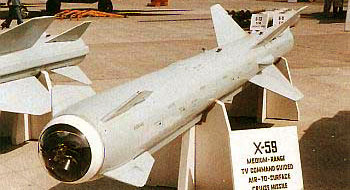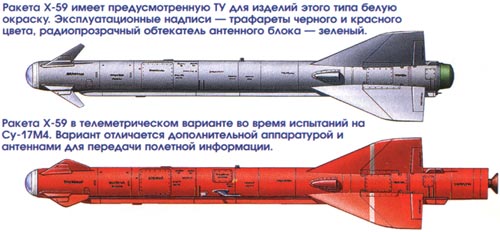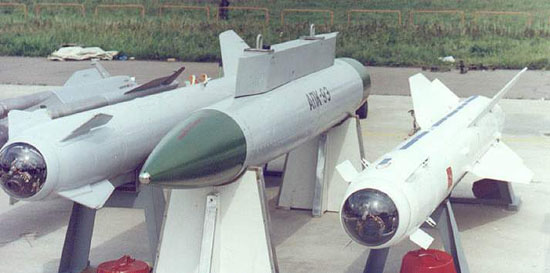Part 1

The development of new generation ASMs took place against the background of the improvement of air defense weapons and ECM systems, which reduced the effectiveness of the previous generation of ASMs. Into service entered SAM complexes, capable of striking not only aircraft and helicopters, but also of ensuring the antimissile defense (for example, domestic S -300 and American "Patriot"). Radical solutions were required in the ASM guidance and control systems, which would make it possible to reach increased distances with high accuracy, ECM protection and small vulnerability. Tasks were contradictory, and of conflicting nature: launching from the distant boundaries out of the air defense zone of enemy hampered aim designation and guidance, "aid" from onboard of carrier aircraft mixed the reticence of application, and reaching high speeds led to the complication of construction and control of rocket, requiring transition to the new materials, element base and more powerful steering drives.
After turning to the theme of ASMs for frontal aviation, Raduga, which previously specialised in long range cruise missiles for VVS/AVMF (only exceptions were antiradar missiles Kh-28 and Kh-58), used the produced experiment for the development "Article D-9", accepted for the armament as the "complex of air armament Kh-59 "Ovod". From previous precision ASMs, Kh-59 differed in terms of substantially larger range.
Kh-59 became the development of successful construction Kh-29T with television seeker, recommended itself as high-precision weapon, with the use of a number of the successful technical solutions from Kh-58. However the initial intention to create the "TV version" of Kh-58 it was necessary to reject: the high-speed flight profile of Kh-58 did not allow the required time for the search, recognition and "locking on" to the target of the television seeker. On the approach to the target the sufficiently tedious and prolonged procedure, which requires the participation of pilot, forced a reduction in speed by this stage, ensuring sufficient time for the aim designation.

Kh-59 was intended for the damage of important objects, as a rule, covered by air defence assets. In view of this the guarantee of shooting from medium distances (up to 40 km), was required for the missile, realized with the two-stage guidance system: autopilot in the initial phase of flight with radio-command and subsequent homing on arrival to the boundary of target detection. Target position must be established before launch, and its coordinates programmed in the memory unit (PRNK) of carrier. On arrival to the area of 5-10 km from the target begins the command control with the aid of the TV seeker.
The advantages of the tele-command guidance system (TSKN) Of "Tekon-1" (named on the designation of L'vov NPO, noted for also its television sets) were the possibility of "remote" search and detection of target, achieved with the aid of the television head at the significant distance from the carrier (before this process was achieved, with the locking on of missiles before launch, range was limited to visual distances); the considerably increased accuracy of terminal guidance by pilot, possible practically to the destruction of target; the realization of all-angle control of missiles, including after withdrawal of aircraft from the target. The APK-9 guidance pod, equipped with front and rear hemisphere antennas, ensures the process of guidance, even after the carrier aircraft has turned to the reverse heading, making it possible for aircraft to break off after launching, without entering into the zone of the antiaircraft fire, but radio-command correction in real time it made it possible to confidently strike even low-contrast objects, "inappropriate" for usual TGSN, to which those could not carry out a contrast lockon.
During the tests of the Kh-59 armament complex on Su-17M4, outstanding results were achieved: the missiles repeatedly struck the target within a radius of 1-1.5 m of the "cross". Testing ended in with positive conclusion in 1984 and Kh-59 was recommended for equipping the existing fighter-bombers in the arsenal, but, in the final analysis but this was changed in favor of the Su-24M frontal bombers, where the navigator could operate in the guidance role. The solution was justified by not so much ergonomic considerations, as the ending of Su-17M4 production. As a result, the Su-24M became the only aircraft type of the Soviet and Russian VVS armed with Kh-59. For the creation of "high-precision aviation complex X -59" its developers were awarded the state prize in 1984.

For guidance, the two-way datalink is used. On the video channel onboard the carrier aircraft is transferred the target image from the flight course of the missile, and the operator, retaining the target in the crosshairs of the screen of video command device, accomplishes semiautomatic guidance on the radio command channel. Following the successful lock-on of a high contrast object by the TV seeker, it can be transferred into automatic homing mode. Locking the TV seeker to the target is achieved by moving the cursor of the sight over the image of the selected target on the screen (similar to how as is done in computer games), and launching, from the low altitudes and from the significant ranges, out of the lock-on range of the TV seeker.
Kh-59 has a canard layout with the developed wing and destabilizers which are folded for transport and during carriage. The missile has two solid propellant motors: a jettisonable boost engine at the rear, and two-nozzle sustainer (the return to two lateral nozzles was caused by the datalink antenna block in the tail section), the first of which fires during the initial autopilot stage, and then is jettisoned by pyrotechnic charges, freeing the datalink antennas. Flight continues with the aid of the second stage sustainer rocket engine, which has a small specific impulse supporting subsonic speed in the order of 285 m/s. For the protection of the television seeker head window from the dust and insects (especially a problem in low altitude flight) in flight under the carrier Kh-59 has a light metallic spinner AMG-6, jettisoned during launching and deployment of the canard “whiskers”. The warhead is explosive, with penetrating action, weighing 148 kg, that ensures the damage of basic targets - shelters, depositories, staffs and other protected construction.
As in Kh-58, control of the missile is achieved by electromechanical steering drives, which feed from an onboard storage battery and converter. For the realization of low-altitude flight it has a radio altimeter. Basic structural materials are light alloys and high-strength stainless steel. VNS-2 in the aggregates of fuselage, wings welded from the light alloy AMG-6 with the longerons from VKL-3. For guaranteeing the heat insulation loading compartment and apparatus sections Kh-59 are covered over by the layer of synthetic material, and fairing with reinforcement and installation of power supply for increasing the hardness is flooded by foam plastic together with the plaits established in it and by joints. For the suspension and the launching of Kh-59 serves the standardised aircraft ejection device AKU-58-1.
Picture (scheme): link
Developer: Raduga
Producer: Smolensk aircraft factory
Length: 5.368-5.37 m
Diameter: 380 mm
Span: 1.26m (1.17m)
Weight: 760-790 kg
Speed, 285 m/s (250-300)
CEP: 2-3 m (3-5)
Range: 40km
Warhead: 147-148 kg explosive-cumulative
Guidance system: TV+command
Carrier aircraft: Su-24M, Su-17M4, Su-30MK
The airborne launcher:
Type: AKU-58-1
Number of rockets on launcher: 1
Developer: Vympel
Weight, empty launcher: 185 kg
Length: 3810 mm
Width: 130 mm
Height: 220 mm
Translated from http://www.airwar.ru/weapon/avz/x59.html
__________________
Paul Martell-Mead / Overscan
http://www.overscan.co.uk/Avionics.html

